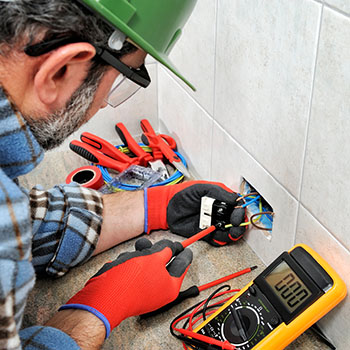Data Wiring Knowledge Center
Tools of the Trade
The life of someone who installs data wiring can make their lives easier just by having the right tools of the trade. Without the right equipment you do a disservice to your client and your business. Not only will it take you twice the time it would if you had quality tools at your disposable but your finished product won’t look as good either.

We Have the Right Tools for the Job!
Choosing the right tools for the job require a financial investment to obtain a complete kit of quality tools.
Professionals in this field who are looking for tools should expect to spend a few thousand dollars for a quality complete set of equipment, this is an investment not only in the quality of your tools but the success of their future business. For someone who wants to do more basic work spending a few hundred dollars should do the trick.
It’s tempting to acquire the same tools for half the price of the cutting-edge equipment but often you sacrifice durability of the tool and the quality of the work suffers. While you don’t have to buy the most expensive tools on the market, it’s highly suggested that you take the time to price and compare equipment for the right features you’ll need when in the field.
There are several online options and e-commerce sites where you can purchase the tools and parts that you’ll need to complete your first cabling kit. Below you’ll find a small list to start your seach:
- Amazon
- E-Bay
- Jenson Tools
- Supplie Siemon
But if you are one of those people who like to have a feel of tools before you decide to buy them then you are better to search out the local distributors in your particular area. In the Metro Detroit area we prefer ADI supply houses with several in Muskegon and Milwaukee.
Everyday Cabling Tools
Your common cabling technician will have wire strippers, cable crimpers, punch-down tools, fish tape and testing tools. Most of these tools are standard in field, no cabling job could be done without them.

Wire Strippers (aka Snips)
Cable Crimpers
Crimpers are a specifically designed tool for data wiring that applies force evenly when used to connect modular plugs and coaxial connectors to the end of the cables. Some types of crimpers have a ratchet mechanism that ensures a complete crimp cycle has been made. There are two types of cable crimpers to use with twisted pair or coaxial cable and they either have a fixed size crimp opening or come with changeable ends.
Punch Down Tool
A punch down tool is also known as a chrome tool and consists of a handle, spring mechanism and removable blade. Its job is to insert the wires into insulation displacement connectors on patch panels, a punch down box and Keystone modules. It literally punches the wire into place using an impact action (hence the name) and the blade then cuts off any excess wire.
Fish Tapes
A fish tape (also known as a draw wire or tape) is a flexible long steel tape, wire or fiberglass rod that can go around corners and bends without kinking; but is stiff enough to be able to be pushed through long confined spaces.
Voltage Meters
If you want to check if an electrical circuit has a light voltage you could always just touch it, but that isn’t something that we would advise you to do; seriously, don’t do it. So having a simple voltage meter in your kit is always a good idea.
Cable Testers
A cable tester is used to test the strength and connectivity of a particular type of cable or wire and there are numerous types of cable testers available on the market ranging in price from under $100 to over $5,000. The simplest type of tester available is a cable toning tool which is a basic continuity tester to determine that the cable has been properly installed at both ends.
Cable Pulling Tools
Pulling cable can be a monstrous task when you are trying to get the cables through an area between the structural ceiling and a false ceiling. A cable pulling tool can be a godsend for the process and they can be either telescoping pole tools or pulleys that the cables are threaded through allowing for more cables to be pulled without exceeding the maximum tension.
Wire Pulling Lubricant
Another useful tool for wire pulling through conduit or raceways is a special wire pulling lubricant that allows the cables to slide easily over rough surfaces.
Cable Marking Supplies
A professionally installed data wiring system should be properly documented and while some installers even use color coding on the cables, a simple but effective way, is to assign a number to each cable using wire marking labels.
Everyday Cabling Tools
Your common cabling technician will have wire strippers, cable crimpers, punch-down tools, fish tape and testing tools. Most of these tools are standard in field, no cabling job could be done without them.
Ever Wondered What A Professional Network Cabling
Tech Has in their Kit?
Our YouTube videos will show you what every competent cabling technician should carry on a day to day basis! We also have Tutorials, Experts on Location, Tips and even our Extras!

Learn Cabling Basics Step by Step on Your Own
Below we highlight some of the key elements in the network cabling business.
What is Network Cabling?
Unshielded Twisted Pair (UTP) Cable
Unshielded Twisted Pair Connector
The standard connector for unshieleded twisted pair cabling is an RJ-45 connector. This is a plastic connector that looks like a large telephone style connector. A slot allows the RJ-45 to be inserted only one way. RJ stands for Registered Jack, implying that the connector follows a standard borrowed from the telephone industry. This standard designates which wire goes with each pin inside the connector.
Shielded Twisted Pair (STP) Cable
A disadvantage of UTP is that it may be susceptible to radio and electrical frequency interference. Shielded twisted pair (STP) is suitable for environments with electrical interference. However, the extra shielding can make the cables quite bulky. Shielded twisted pair is often on networks using Token Ring topology.
Coaxial Cable
Coaxial Cable Connectors
Fiber Optic Cable
Fiber Optic Connector
The most common connector used wit fiber optic cable is an ST connector. It is barrel shaped, similar to a BNC connector. A newer connector, the SC, is becoming more popular. It has a squared face and is easier to connect in a confined space.
Wireless LANs
Not all networks are connected with cabling. Some networks are wireless. Wireless LANs use high frequency radio signals, infrared light beams or lasers to communicate between the workstations and the file server or hubs. Each workstation and file server on aw wireless network has some sort of transceiver/antenna to send and receive the data. Information is relayed between transceivers as if they were physically connected. For longer distance, wireless communications can also take lace through cellular telephone technology, microwave transmission or by satellite. Wireless LANs have several disadvantages. They are very expensive, provide poor security and are susceptible to inference from lights and electronic devices. They are also slower than LANs using cabling.
Pricing for Network Cabling Installation
By now our clients usually ask what the price is after hearing our almost too good to be true service for our cable installs and wiring. We tackle that problem with a simple solution.
Our Project Manager here at Our Cable Guys LLC would normally provide an intake process that takes walks you step by step to provide you with an accurate estimate that matches the project you bring to us. This allows us to comb over the finer details so we can complete 100% of the job. For example:


Need Help Managing your Network Data Cabling?
We can provide solutions for network cabling data wiring management for all of your projects. We serve the local Metro Detroit areas as well as the surrounding counties.
Placement is vital when it comes to cabling especially in commercial spaces, by prioritizing this we ensure ease of wire management for future troubleshooting or cable replacement.
Get The Newsletter
Subscribe to our newsletter to receive news & updates. We promise to not spam you, super promise!






